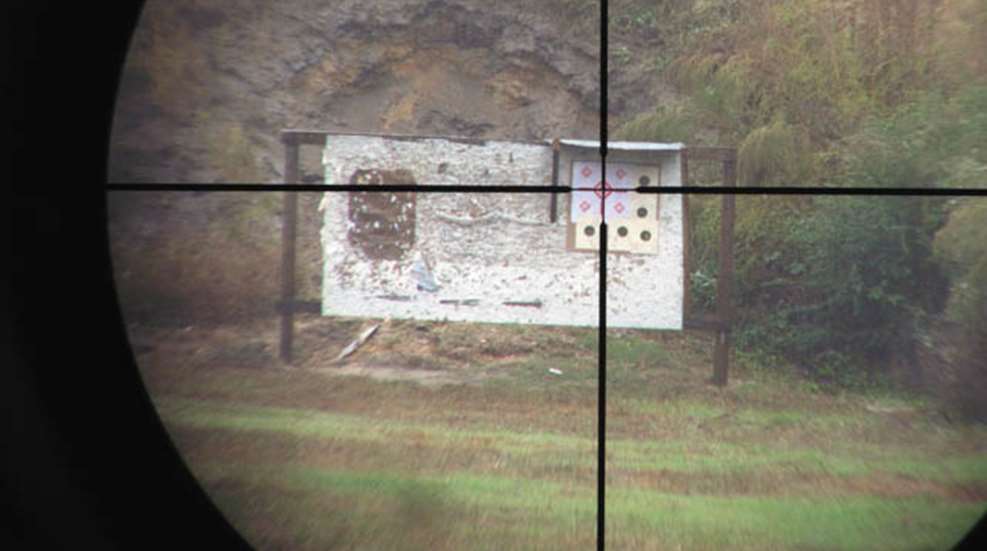
While getting ready, you notice a vague drumming sound coming from outside the house. A quick glance out the window confirms your fears and saps your motivation like a Saturday morning call from the boss. It turns out your local meteorologist is only slightly more accurate than the mustachioed palm reader on the edge of town. This is the point where most sane people I know scrap their plans and find something else to do. While more than two decades as an Army grunt left me with a perpetual hatred of being wet and cold—in that order—every now and then I take advantage of uninvited precipitation to check out my equipment and technique.
Why brave black clouds just to punch holes in paper or splatter some steel? One great thing about foul weather is you almost always have the range to yourself, which is a big plus for antisocial range hogs like me. Another functional benefit is cloudy skies typically improve contrast and make spotting hits on distant targets easier. Prone shooters will enjoy the lack of dust every time their favorite muzzle brake works its tornado-like magic. Wherever noise is an issue, rain (and snow) helps attenuate shooting sounds. You won't notice the difference at the firing line, but the neighborhood a mile away will.
Determining wind speed and direction at long distance is challenging under normal conditions. If you can see rain falling between you and your target, the process is actually easier. Excess water vapor in the air will help spotters see the bow-wave-like disturbance caused by a bullet (aka trace) as it heads downrange. Finally, shooting in the rain is a good test for your equipment. Many optics advertised as waterproof are really only watertight, at best. While no one wants to intentionally create their own personal "can 'o fog," I will take that result over finding out clever marketing and poor quality have spoiled my ability to deal with an important shot at a more serious time and place.
We all know getting drenched while sending your hard-earned dollars downrange just plain sucks. Setting aside the obvious comfort issues, other problems bearing consideration are rust, damage to electronic equipment and ruined targets. As long as you are not using rifles with unfinished or still "in-the-white" steel (stainless is good), your guns will withstand a soaking without trouble. It is very important to dry, clean and lubricate them well as soon as you finish. Electronics not intended for wet weather, such as commercial-grade ballistic computers, need to be kept in dry bags or under cover. I use paper targets when measuring accuracy, so I erect an improvised cover over my target backers when the clouds roll in. A thin sheet of plywood cut to approximately 36 inches by 18 inches or a piece of cardboard wrapped in a trash bag both provide an adequate roof. Either can be stapled or screwed in place on top of the target backer with a pair of 2-inch by 2-inch boards extending to the ground for support. This simple add-on is amazingly effective, even in a downpour.
Seeing your target is another challenge. Dialing down the magnification of variable-power optics usually helps clear things up. Parallax adjustments should be focused at the target or even slightly beyond to eliminate much of the rain seen between riflescope and target. Open sights are normally trouble-free when wet, unless an aperture is present. Small peep sights tend to plug with water drops, requiring effort to keep clear.
Prone firing is a real mess when ground conditions become soggy. I use a Cordura-covered, closed-cell foam shooting mat so water doesn't pool directly on the surface or soak through. When I'm not lying on it, I fold the mat over on itself to try to keep the top side dry(er). No matter what you do, however, you are going to get wet when lying on the ground in the rain.
Other Helpful Hints
Keep a "Rite in the Rain" notebook in your range bag to use for notes on trajectory, conditions, deviations in performance, etc. I discovered these wonders of modern chemistry while going through the Army's Ranger School inthe late 1980s and I have seldom been without one since.
Keep a breathable, water-resistant jacket and pants handy in your range bag. Don't forget a hat, boots and gloves, especially in cold weather. Choose bright colors to help others see you when downrange.
Before shooting a wet rifle, ensure the bore is clear of water. It is possible to plug a barrel with enough water to cause damage when firing. A soft, dry lens cloth in a sealed bag will come in handy when lenses need wiping.
Focus on your shooting, not on the fact that you are being pelted from above. The same level of concentration is needed to contend with rain as when dealing with sweat in the eyes or attacks by squadrons of mosquitoes or gnats.
Use a sunshade for your scope. These thread-on extensions help keep water off your objective lens.
Never take chances with lightning. Seek shelter indoors or in a closed vehicle as soon as you see it or hear thunder. A 60-foot pine growing alongside my local range's firing line bears the marks of a recent direct hit. Remember: lightning can strike several miles away from the main storm.
The desire to stay indoors when the vertical floodgates open is instinctive. I have to suppress the urge to head for higher, dryer ground whenever rain interferes with my plans. However, as with all of my shooting sessions, slinging a few rounds downrange when the barometer dips either teaches or reminds me of something important each time I decide to suck it up. Knowing that when I finish there is a warm woodstove and good coffee waiting for me at home helps, too.






































